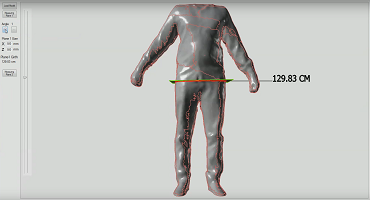Unveiling the Accuracy: A Deep Dive into Bust Measurement in Fashion Design and Healthcare

Introduction
Accurate body measurements are important in fashion design and healthcare, especially when it comes to bust measurements. At 3D Measure Up, we spend a lot of time understanding accuracy in depth, studying and determining the accuracy and improving it. This article presents the results of one such study conducted to analyze bust measurements.
Join us as we reveal insights, findings, and innovative solutions that enhance the accuracy of this crucial girth landmark.
Background: Investigating Disparity
- The history of measuring male bust sizes in body scanning revealed an interesting challenge for the 3DMU team.
- It was observed that the measured bust sizes of males were consistently larger than their actual measurements. Even when measurements were taken around the nipple area, similar to using a tape measure on a real body.
- On the other hand, measuring bust sizes for females proved to be more accurate.
- In ideal scenarios, where the measurements from the scan were compared to the tape measure, the difference was less than 1 cm, which is considered very close.
- This discovery prompted our engineers to investigate the reasons behind the disparity in bust measurements. Their aim was to understand the complexities of body composition and scanning techniques in order to improve measurement accuracy.
Comprehensive Study: Delving into the Details
- The study involved three expert measurers (people who have expertise in taking body measurements manually) and the 3D Measure Up technology to measure the busts of the participants.
- A total of 26 scans were performed, and each scan was independently measured by all three experts.
- The bust girth measurements obtained from the scans were recorded and analyzed for consistency and validity.
- Statistical measures, such as standard deviation and maximum deviation, were calculated to quantify the variation in the measurements obtained by the expert measurers.
- Additionally, the consistency between the 3DMU measurements and the measurements taken by the expert measurers was evaluated.
- The study also took into account the impact of tilt and tessellation on the accuracy of bust measurement.

Observations and Analysis: Unveiling the Findings
- The measurements taken from 30 different models in various poses showed that the bust measurements had an average difference of about 12mm. The largest difference observed in the bust measurement was approximately 46mm. Interestingly, in certain cases, there were differences of around 60 mm between the measurements taken by different expert measurers.
- In some scans, the bust measurement extended beyond the armpit boundary and included the biceps.
- In all cases, the bust measurement obtained through the 3D Measure Up was considered valid based on the definition: it is the horizontal tape girth measured at the level of the bust point, which is the frontmost point on the bust.
- By adhering to this definition, the 3D Measure Up system ensured that the bust measurements obtained were consistent and aligned with the required anatomical reference point.
- However, it is important to note that the measurements obtained from 3D Measure Up were similar to the measurements taken by at least one of the expert measurers.
Proposed Solutions by 3D Measure Up
Advancing Accuracy
Based on the research, the 3DMU team implemented several solutions to address the bust measurement issues:
- The team addressed stray meshes and improved the profile of the bust girth, specifically targeting overshooting bust girth. Due to this, the measurements improved by 1 cm but were still beyond the expected tolerance limits
- Later, additional bust measurements were added, such as Bust 2 (with different front and back armpit points) and Bust Straight (reducing the bust measurement by a fixed percentage).

- Again even if the measurements improved it on some scans caused the girth to follow a path inside the mesh causing incorrect measurements in other models
- The team then came up with combination of measurements to get the bust measurements i.e. it included Front Bust width, Back Bust width and Straight distance between the armpits
- Further, 3DMU team compared the cross-sectional shapes of the torso in the Relaxed and A & M poses using Meshmixer. By slicing the models at the Bust points, they overlaid and compared their cross sections. Notably, there was a significant difference in the torso shape when the arms were closer to the body. The team considered using BMI as a ratio to adjust for this change, but found it to be an unreliable parameter.

- 3DMU then compared its measurement with different tools like Meshmixer and Meshlab. The Full body and Sections at the bust level were close to the measurements with tools.
- These findings further contributed to the understanding of the complexities involved in obtaining precise bust measurements.
Enhancing Understanding: Unveiling Complexities
Through meticulous analysis and comparisons with various tools, our study deepened our understanding of the complexities involved in obtaining precise bust measurements. We remain committed to continuously refining our measurement techniques and implementing innovative solutions, ensuring the utmost accuracy in bust measurements at 3D Measure Up.
Conclusion
Accurate bust measurements are pivotal in fashion design and healthcare. At 3D Measure Up, we are proud to share the insights and solutions gained from our comprehensive study, all aimed at enhancing the accuracy of bust measurements. By advancing our understanding and techniques, we continue to set new standards in precision scanning, empowering industries worldwide with reliable and accurate body measurements.
For more queries regarding any of the above-mentioned topics, feel free to connect with us on our website https://3dmeasureup.ai/, or email us at 3dmeasureup@prototechsolutions.com




